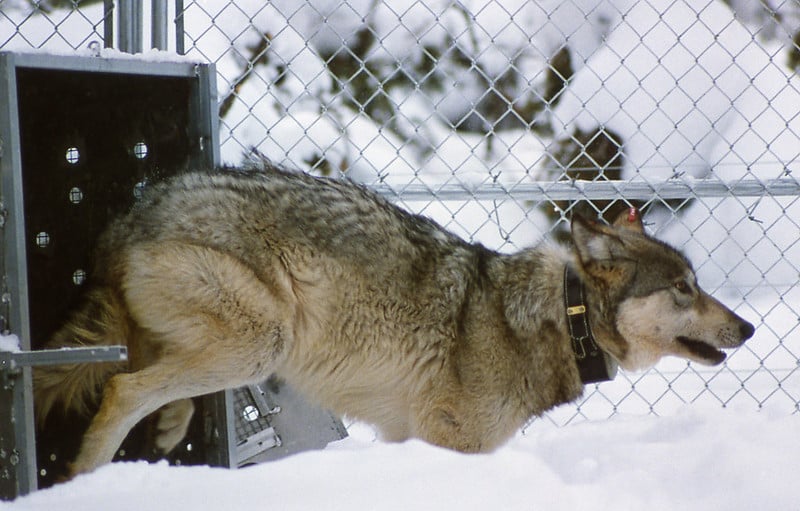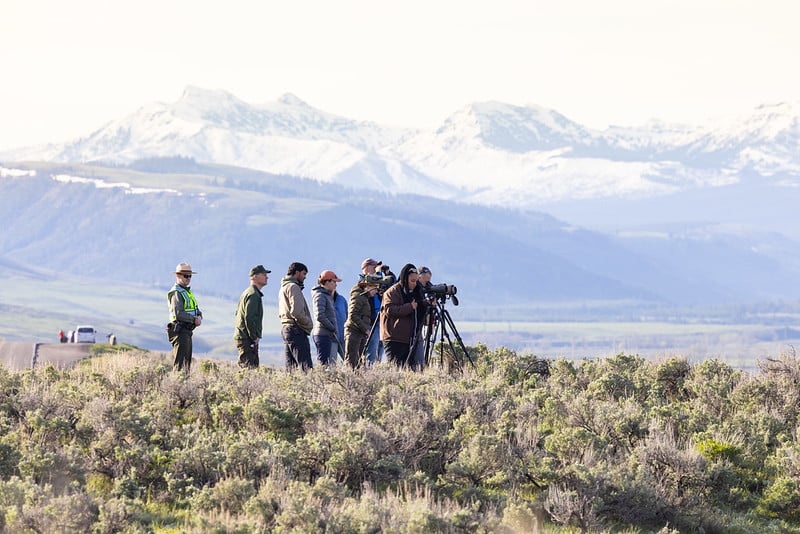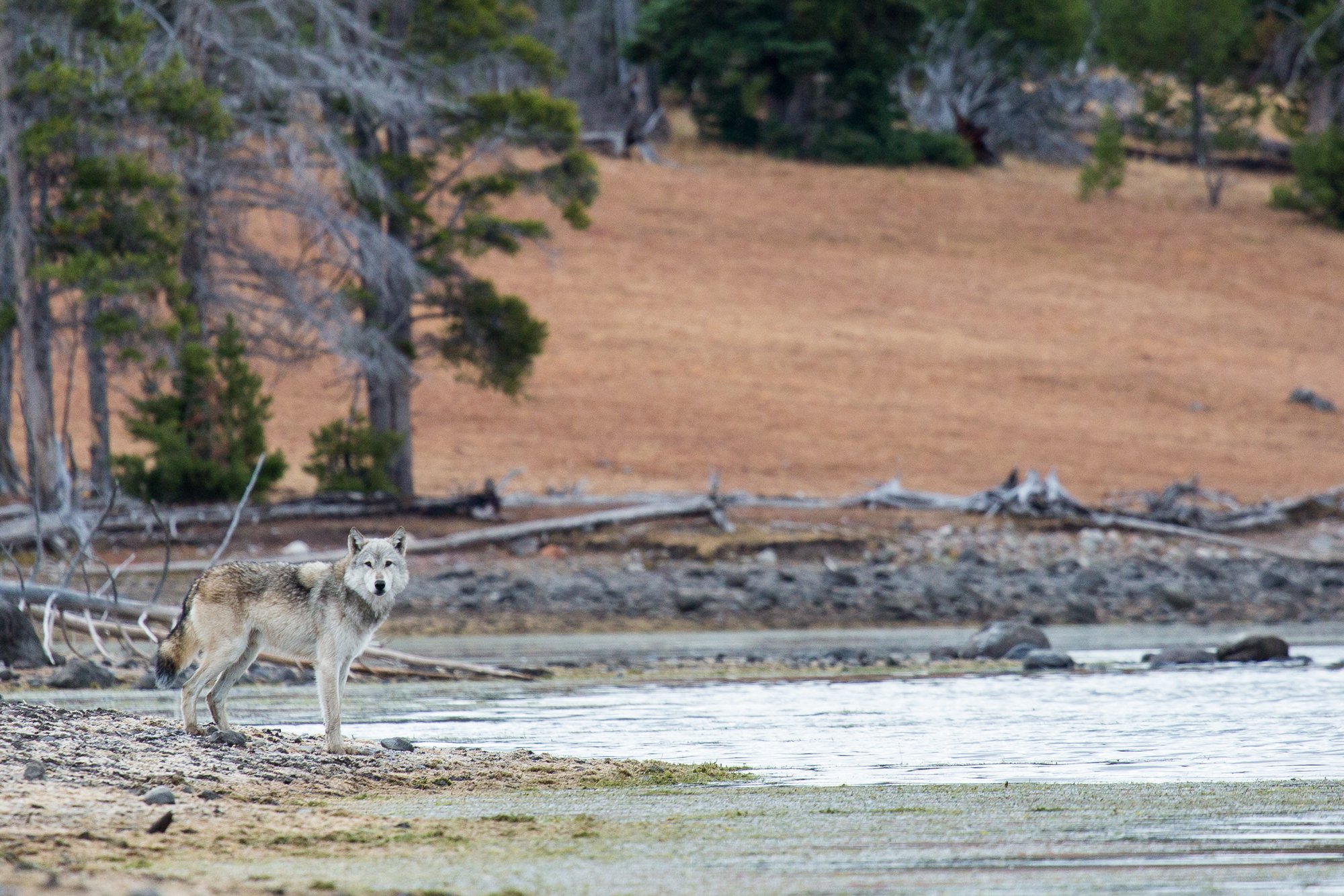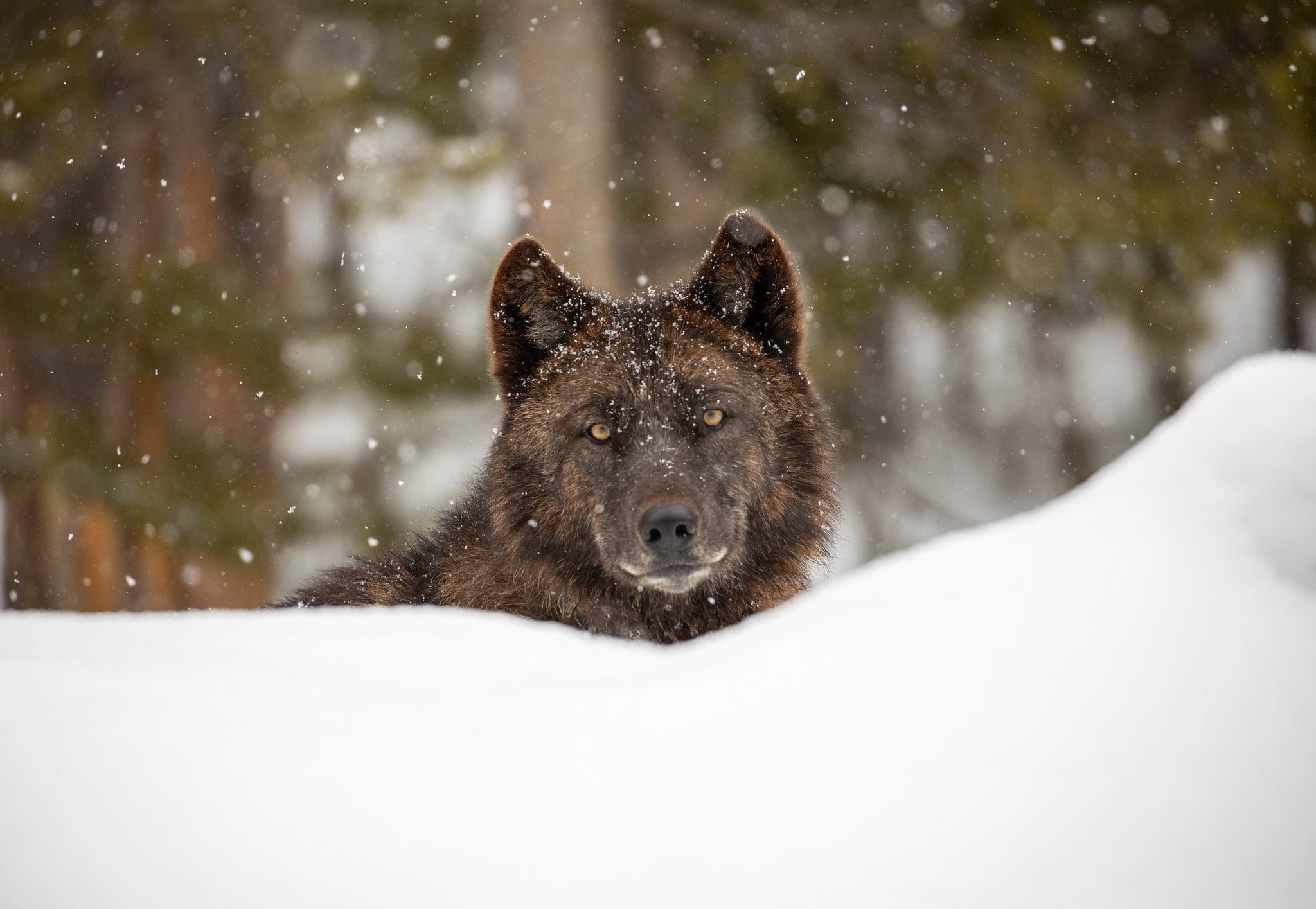Yellowstone: Wolf Watching in Wonderland
Yellowstone Wolves
Buffalo may be the showstoppers in Yellowstone, but wolves are superstars in their own right, attracting countless avid wolf watchers to the park each year.
“Wolf watching is addictive,” says Amanda Hagerty, the Director of Education at Gardiner, Montana-based Yellowstone Forever, the official nonprofit partner of Yellowstone National Park. She once spent almost an hour watching wolves nap. “This was my first time seeing wolves during the winter season. But we could see them just lying on their sides and sleeping on the top of a hillside; they looked like they didn’t have a care in the world.”
To serve the legions of wolf fans, like Hagerty, Yellowstone National Park Lodges and Yellowstone Forever offer guests in-depth wolf- and wildlife-watching trips in the park. With a bit of luck, persistence, and patience, visitors can improve their odds of spotting these shy, elusive creatures.
Among the tours offered by Yellowstone National Park Lodges are:
- Wake up to Wildlife: a 4.5-hour early-morning tour of the wolf-rich Lamar Valley to find wolves and other megafauna grazing or hunting on the open hillsides
- Evening Wildlife Encounters: a 4.5-hour search for wildlife in the Tower-Roosevelt area, which may end up at the Lamar Valley
- Madison Wildlife Excursion: a partial-day winter tour along the 7-mile corridor that parallels the Madison River west of Madison Junction
Yellowstone Forever offers three 5 day, 4 night Lodging & Learning packages from Mammoth Hot Springs hotel. These packages include lodging, transportation, food, and a knowledgeable Yellowstone Forever field guide to ensure “prime” wolf watching opportunities in every season.
- Fall Wolf and Elk Discovery Package
- Spring Wolf and Bear Discovery Package
- Winter Wolf Discovery Package

Wolf Reintroduction
Wolves are one of the biggest success stories of returning wildlife to an ecosystem from which they had disappeared. Hunted to extinction in the Greater Yellowstone Ecosystem, and the American West, in the first several decades of the 20th century, the species was reintroduced in 1995. That year, 14 wolves captured in Canada were brought to Yellowstone National Park’s Lamar Valley. The following year, another 17 wolves from Canada were released in Yellowstone. (Simultaneously, a similar number were released in central Idaho wilderness areas.)
Five years of reintroductions were expected to establish a population in Yellowstone. But the wolves became self-sustaining after only two years. And the goals set by the U.S. Fish and Wildlife Service for the species’ recovery in the area — 450 wolves and 45 breeding pairs in Montana, Wyoming, and Idaho — was reached by 2000.
Today, more than 3,300 wolves are estimated to live in Wyoming, Idaho, Montana, Washington, and Oregon. Yellowstone’s Lamar Valley is known as one of the best places in the world to see these canines in the wild. Ronan Donovan, a Bozeman, Mont.-based National Geographic photographer who spent months in Yellowstone photographing wolves in 2015 and whose exhibit Wolves is on exhibit at Jackson, Wyoming’s National Museum of Wildlife Art through April 2023, says, “The Lamar Valley is one of the premiere places in Yellowstone to see wolves because of the abundance of wolf prey — elk and bison — and also because of its open landscape, which allows viewers to spot wolves from miles away without affecting their behavior.”

Spotting Wolves
John Wallingford, who has been leading tours on and off in Yellowstone since 2004, says that when guests on the daily Wake up to Wildlife Tour see wolves, “the reaction from most people is awe or wonder or sublimity.” Seeing wolves he says, gives visitors, “a feeling of connection that transcends who we think we are. It reveals that we are part of a bigger picture.”
Of course, wolves are wild animals and seeing them is not guaranteed. Wallingford preps the visitors on his tours. “Finding wolves is like trying to predict a flash of lightening,” he says. “I can take visitors into the storm, but we don’t know exactly where lightning will strike.”
Still, the guides for Yellowstone National Park Lodges and also for Yellowstone Forever avail themselves of the most recent reports of where wolves have been spotted. “There are reports we look at that give us an idea of where wolves were recently,” says Peter Goodman, who has been working in Yellowstone since 2018. Guides also communicate with each other via radios, sharing if they’ve spotted a pack.
Wolf watching on your own is also possible. If there are wolves visible from the road between Mammoth and the northeast entrance at Cooke City, a crowd will gather. If you see people on the side of the road, pull over and don’t be shy about (politely) asking what they’re looking at. Wolf watchers tend to be friendly, although it’s good manners to have your own pair of binoculars. (Binoculars are a minimum; most wolf watchers have high-powered spotting scopes mounted on tripods.) If you have a day to dedicate to wolf watching, doing laps — slowly — on the road between Tower Junction and Cooke City will give you the best chances of seeing them.
Goodman has mostly spotted the Junction Butte and Wapiti Lake wolf packs. “A lot of times, the Wapitis are seen on the road between Mammoth and Old Faithful,” he says. A resident of Gardiner, just outside the park’s northern entrance, Goodman says that on his days off he’ll look for wolves in the Lamar Valley. One recent spring, the pack’s den was “fairly visible” from the road. “I watched the pups grow up that spring,” he says.

Winter Watching
If you want to make your odds of seeing wolves in Yellowstone as high as possible, you need to visit in the winter. While the park is more difficult to get to then, when it is buried beneath an average of 10 feet of snow, that season is the best time of year to see these furry animals. Goodman says, “Winter is their season; they’re built for winter and it is the season they are most active. Summer is too hot for them (when) they’re mostly active at night and are bedded down in the shade napping during the day. In winter, they’re hunting and active during the day.”
“In winter, the Lamar Valley truly feels like a wonderland,” says Yellowstone Forever’s Hagerty. “There is a blanket of snow stretching endlessly across this massive valley and you are provided the rare opportunity to see wolves going about their everyday lives. It is both a special and surreal feeling.”
“Most people who come to Yellowstone in the winter want to see a wolf and when they do, I see them just light up with excitement,” Goodman says. “They’ll say that they can’t believe it, and even though I’ve seen a lot of wolves, I’m the same. I still get excited every time I see one, and am thankful to live and work in a place where something so extraordinary is possible.”

Photographing Wolves
In conjunction with his photography exhibit, Wolves, at the National Museum of Wildlife Art in Jackson, National Geographic photographer Ronan Donovan shared his tips for photographing wolves in Yellowstone in the museum’s annual Call of the Wild magazine. Here is his advice:
“Photographing wolves in and around Yellowstone is hard; the landscape is difficult to navigate and the wolves are shy, so having an upfront realistic expectation is a good idea. I spent a year trying to photograph wolves in Yellowstone and all the images that were published were taken during a two-week span when everything came together.
“It is illegal to get closer than 100 yards to a wolf in Yellowstone and Grand Teton National Parks. Your best bet is to head out early in the morning, before sunrise. Stop and listen and try to hear howls, use binoculars or a spotting scope to scan the landscape. If you have limited time and can afford it, you’re better off hiring a wildlife guide who knows the behavior and patterns of local packs. If you can’t do that and are in Yellowstone, there are almost always people along the roads with spotting scopes who are happy to answer questions and share information about where wolves have been spotted that day.”
Written by: Dina Mishev
Dina Mishev is the editor in chief of Jackson Hole magazine.
20221208
For A World of Unforgettable Experiences® available from Xanterra Travel Collection® and our sister companies, visit xanterra.com.
Want to experience Yellowstone in-depth? See what makes Yellowstone National Park a great place to work for a season or longer!
Read More
- Read More